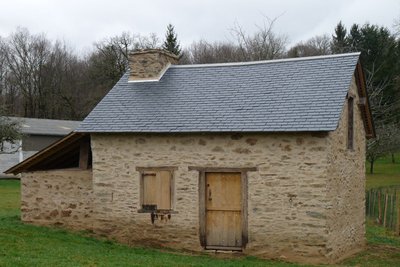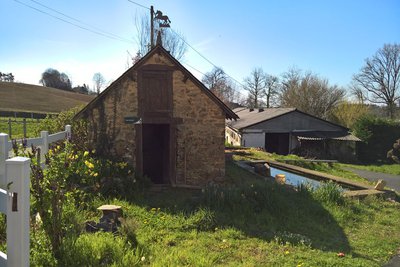Ovens Circuit

Rilhac-Treignac
Ovens Circuit
Easy
1h30
5km
+102m
-103m
Loop
Yellow markers
Embed this item to access it offline
A circuit rich in landscapes, between the Monédières massif and the Vézère Valley, where history and tradition can be traced through the local bread ovens.
9 points of interest

Le Four Communal - Office de tourisme V2M  Small patrimony
Small patrimonyThe Communal Oven
This oven, which dates back to the 19th century, has belonged to the commune since 2012. Renovation work has been carried out on it. It is built in granite, its roof is made of Corrèze slate, and it also has a drying room (clédier).
Le Four "Lauzanne" - Office de tourisme V2M  Small patrimony
Small patrimonyThe “Lauzanne” Oven
The unusual thing about this 19th-century oven is that it is composed of two parts. The oven is made of stone and brick while the shelter serving as an entrance is made of wood. It is completely covered in tiles. At the back of the oven, there is a small room where the faggots of kindling were dried to heat the oven.
Le Four "Lestrade" - Office de tourisme V2M  Small patrimony
Small patrimonyThe “Lestrade” Oven
This 18th-century oven has undergone various transformations: the roof was redone and the chimney, which was in very poor condition, was removed. Opposite it, there is a well with a curbstone that includes a stone from a château that once existed next to the church, representing the coat of arms of Rilhac-Treignac and its three scallops, somewhat erased with time. In addition, the road between these two buildings bears the traces of an ancient Gallo-Roman paved road, and the stones on the ground still bear witness to that to this today.
Four rénové - A.Belin - PNRML  Small patrimony
Small patrimonyThe “Jorby-Caudy” Oven
This 19th-century oven, paved inside, has recently been renovated on the outside. In this one, apart from making bread, its former owner used to make his wicker or chestnut baskets in the winter, as well as many other tools for farm work.
Le Four du "Genêt" - Office de tourisme V2M  Small patrimony
Small patrimonyThe “Genêt” Oven
This XIX/XXth century oven has several parts: the oven, the dryer and the pre-oven. The small pond that borders it gives it all its charm.
Le Four du "Teyssier" - Office de tourisme V2M  Small patrimony
Small patrimonyThe “Teyssier” Oven
The remarkable thing about this oven from the XIX/XXth century is that it is composed of two parts.
It consists of a vault and a hearth made in refractory bricks. And in front of this oven is a room where the wood for heating is kept. The clédier (upstairs) is made of chestnut. This was used to dry chestnuts and walnuts but was also used as a store for broom which, once dried, was used to light the oven. The oven still works regularly, which ensures it keeps all its authenticity.
Le Four de la "Goupillère" - Office de tourisme V2M  Small patrimony
Small patrimonyThe “Goupillère” Oven”
This 19th-century oven is an integral part of the house. As, indeed, can be seen from the outside of the house. It is located in the main room where a family once lived. The father was a saboteur and meruiller (bell ringer).The “Goupillère” Oven”
L'Eglise et son chêne de Sully - Office de tourisme V2M  Heritage site
Heritage siteThe Church and its Sully oak tree
Rebuilt in the 15th or 16th century, on the remains of buildings probably dating from the 12th century; only the north chapel has retained its ribbed vaults. The building, flanked to the north by a single chapel, has a pretty two-bay bell-tower-campanile. Its small bell is dated 1741.
The interior, covered by ribbed vaults in the 13th century, has a graceful Rococo altar, with an urn-shaped tabernacle decorated with a gilded bas-relief representing the Good Shepherd. On each side, on a painted wall, two niches house the polychrome wooden statues of Saint Anthony with his piglet and of Saint James.
Sully, a minister of Henri IV, had oak trees planted at crossroads all over France. These trees were also intended to shelter the assemblies of the villagers held at the end of the mass to deal with parish business. This is why we still find many of them, even today, next to churches.
Le Massif des Monédières - Office de tourisme V2M  Panorama
PanoramaThe Massif des Monédières
The Monédières massif is one of the seven landscape entities attached to the Millevaches Regional Natural Park in Limousin and covers an area of about 60 km². This protected granite territory is located in the foothills of the Massif Central, to the south-west of the famous Millevaches plateau. Its dry moors are classified as Natura 2000 areas, synonymous with it being an exceptional site for flora and fauna.
Description
2 circuits available: a short circuit (4.7 km - 1hr 30mins) and a long circuit (9.7 km - 2hrs 30mins)
- Go towards the church next to the Presbytery, where you will find Sully’s majestic lime trees. Continue behind the church, a lectern allows you to discover the Massif des Monédières and the Vézère Valley.
- Then leave in the direction of the main road (Uzerche Chamberet).
- Turn right at the communal oven and continue straight ahead. After 200 m, on the left, it is possible to see the “Lauzanne” oven.
- Follow the path that leads to a road, turn right, and you can see the “Jorby-Caudy” oven on the left. Continue along the road, and 100 m further, on the right, you will find the “Faroux” oven.
- Shortly after, turn left at the well. At the end of the path, a round trip allows you to see the oven of “Le Genêt” 150 m further on. Retrace your steps and turn right to go through the hamlet of Le Teyssier.
- At the crossroads, go past the “du Teyssier” oven, continue right until you reach the Rilhac-Treignac sign, and turn left towards La Goupillère.
- In the village, from the path, you can see the “La Goupillère” oven. Continue along the path that runs alongside the meadow, then climb the path to the right after the small stream.
- Once you get to the road, turn right and follow the path back to Rilhac-Treignac (short circuit of 4.7 km). Or turn left and follow the yellow markings (long circuit + 5 km).
- Departure : Place de la Mairie, Rilhac-Treignac
- Arrival : Place de la Mairie, Rilhac-Treignac
- Towns crossed : Rilhac-Treignac
Forecast
Altimetric profile
Recommandations
It is possible to make a longer circuit: 9.7 km - 2hrs 30mins
Information desks
Le Bourg, 19260 Rilhac-Treignac
1 place de la République, 19 260 Treignac
Transport
Nearest railway station: Uzerche (20 km).
Access and parking
At 13 km from Treignac, follow the D20. 20 km from Uzerche or Chamberet, follow the D3. 10 km from Lonzac, follow the D24 via Peyrissac.
Parking :
Town Hall car park, Rilhac-Treignac
Report a problem or an error
If you have found an error on this page or if you have noticed any problems during your hike, please report them to us here:
